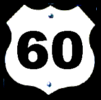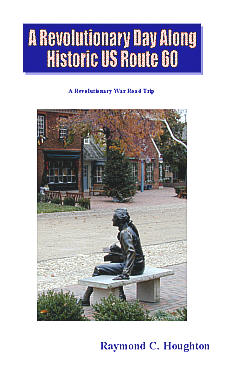A REVOLUTIONARY DAY ALONG
|
 |
A REVOLUTIONARY DAY ALONG
|
 |
 US
Route 60 extends coast-to-coast, from Los Angeles, CA to Virginia Beach, VA, but in its
last 150 miles, Route 60 tracks the end of the British Southern Campaign to its
conclusion at the Battle of Yorktown, the last major battle of the Revolutionary
War.
US
Route 60 extends coast-to-coast, from Los Angeles, CA to Virginia Beach, VA, but in its
last 150 miles, Route 60 tracks the end of the British Southern Campaign to its
conclusion at the Battle of Yorktown, the last major battle of the Revolutionary
War.
The campaign began with three invasions of Virginia by sea and ended with a fourth invasion from the south by land. During the four invasions, British forces ran roughshod over Virginia until the Americans surrounded them at Yorktown. General Cornwallis, the British commander of the southern campaign, saw Virginia as the keystone to the rebellion. It was the largest colony and one of the richest. It was also centrally located and control of the state would cut-off supplies and communications.
General Clinton, commander of all British forces, began the campaign by sending the first invasion force in May of 1779 from his headquarters in British-held New York City. This army attacked and destroyed Virginia’s eastern ports, including Norfolk, Portsmouth and Suffolk. Not far from this attack was Williamsburg, the colonial capital of Virginia. The legislature decided to move the capital to Richmond, which was viewed as a safer, more central location.
The second invasion sent by Clinton arrived in December of 1780 and was led by the newly commissioned British General and American traitor, Benedict Arnold. As Arnold’s army began to threaten Richmond, the capital of Virginia, the Virginia legislature moved their proceedings to Charlottesville.
Clinton’s third invasion arrived in March of 1781 under the command of General William Phillips. He had been sent to take charge of all British forces in Virginia as Clinton still did not necessarily trust the turncoat, Benedict Arnold. Phillips, who outranked Arnold, could keep an eye on him, but Phillips contracted typhoid fever. When the disease eventually took his life, Arnold took charge of the forces of the combined armies of the second and third invasions.
 The
fourth and largest invasion led by General Cornwallis began deep in the south
with successes in South Carolina and Georgia. Despite the southern victories,
they were unable to completely destroy the Southern Department of the
Continental Army and chased them northward toward Virginia. In May of 1781,
Cornwallis invaded Virginia and took command of all British forces in Virginia
including Arnold’s combined second and third invasion forces. The campaign
would end with the American siege at Yorktown and Cornwallis’ surrender,
effectively ending British attempts to regain control of the American colonies.
The
fourth and largest invasion led by General Cornwallis began deep in the south
with successes in South Carolina and Georgia. Despite the southern victories,
they were unable to completely destroy the Southern Department of the
Continental Army and chased them northward toward Virginia. In May of 1781,
Cornwallis invaded Virginia and took command of all British forces in Virginia
including Arnold’s combined second and third invasion forces. The campaign
would end with the American siege at Yorktown and Cornwallis’ surrender,
effectively ending British attempts to regain control of the American colonies.
A Revolutionary Day along Historic US Route 60 begins early in the morning at the University of Virginia and downtown Charlottesville, where an early warning allowed the Governor of Virginia, Thomas Jefferson, and most of the Virginia Assembly to escape British capture.
From Charlottesville, the road trip heads south to the James River with stops at Monticello, the home of Thomas Jefferson and Ash Lawn-Highland, the home of President and Revolutionary War Officer, James Monroe.
After crossing the James River at Scottsville, the road trip joins US Route 60 and turns east through Powhatan to Richmond, the capital of Virginia from 1780 to present. On March 20, 1775 at the Second Virginia Convention in Richmond, Patrick Henry delivered his famous “Liberty or Death” speech, which echoed throughout the thirteen colonies and became the clarion call to revolution.
From Richmond, the road trip continues east through New Kent to Williamsburg, the second capital of Virginia and center of Revolutionary War activities for most of the war. Today, Colonial Williamsburg is one of the oldest and largest living history museums.
From Williamsburg, the road trip continues east along the Colonial Parkway to the Yorktown battlefield. In October 1781, the last major battle of the Revolutionary War would be fought here.
So, if you're
ready
